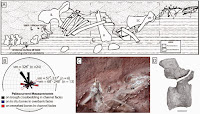Titanosaurs were a group if exceptionally large Sauropod Dinosaurs that dominated many faunas in the Southern Hemisphere during the Cretaceous. The group includes the largest known Dinosaurs, with species such as Argentinosaurus and Puertasaurus thought to have weighed close to 90 tonnes. However the group was quite diverse, and also contained many smaller species, as well as both long and short-necked forms, suggesting a wide range of ecological specialisations.
In a paper published in the journal Scientific Reports on 18 January 2016, Bernardo González Riga of the Laboratorio de Dinosaurios at the Universidad Nacional de Cuyo and the Consejo Nacional de Investigaciones Científicas y Técnicas, Matthew Lamanna of the Section of Vertebrate Paleontology at the Carnegie Museum of Natural History, Leonardo Ortiz David, also of the Laboratorio de Dinosaurios at the Universidad Nacional de Cuyo and the
Consejo Nacional de Investigaciones Científicas y Técnicas, Jorge Calvo of the Centro Paleontológico Lago Barreales at the Universidad Nacional del Comahue, and Juan Coria, again of the Laboratorio de Dinosaurios at the Universidad Nacional de Cuyo describe a new species of Titanosaur from the Late Cretaceous Plottier Formation of southern-most Mendoza Province in northern Argentina.
The new species is named Notocolossus gonzalezparejasi, where 'Notocolossus' means 'Southern Colossus' and 'gonzalezparejasi' honours Jorge González Parejas for his help and legal advice on the Dinosaurs of Mendoza Province and the preservation of the sites that produce them. The species is described from a fragmentary specimen comprising two vertebrae, the right humerus and part of the pubis. A second specimen is also described, comprising seven partial vertebrae and the right hind foot and ankle.
Geographic provenance and speculative reconstruction of the gigantic Titanosaurian Sauropod Dinosaur Notocolossus gonzalezparejasi. (a) Type locality of Notocolossus (indicated by star) in southern-most Mendoza Province, Argentina. (b) Reconstructed skeleton and body silhouette in right lateral view, with preserved elements of the holotype in light green and those of the referred specimen in orange. Scale bar is 1 m. González Riga et al. (2016).
The humerus is the longest and widest recorded in any Titanosaurian Dinosaur (or anything else) at 1760 mm in length, 720 mm wide at its proximal end and 250 mm wide at its midshaft, suggesting that this is one of the largest, if not the largest, Dinosaurs to have lived (many Titanosaurs are known only from partial specimens, so not all have described humeri).
Appendicular skeletal morphology of Notocolossus gonzalezparejasi. (a) Right humerus of the holotype in anterior view. Proximal end of the left pubis of the holotype in lateral (b) and proximal (c) views. Right tarsus and pes of the referred specimen in (d) proximal (articulated, metatarsus only, dorsal [= anterior] to top), (e) dorsomedial (articulated), and (f) dorsal (disarticulated) views. Abbreviations: I–V, metatarsal/digit number; 1–2, phalanx number; ast, astragalus; cbf, coracobrachialis fossa; dpc, deltopectoral crest; hh, humeral head; ilped, iliac peduncle; of, obturator foramen; plp, proximolateral process; pmp, proximomedial process; rac, radial condyle; ulc, ulnar condyle. Scale bars, 20 cm (a–c), 10 cm (d–f). González Riga et al. (2016).
Preserved feet in Sauropods are extremely rare, and this is only the sixth Titanosaur foot described. This makes it difficult to assess trends within the group with confidence, however the discovery a foot in what is the potentially the largest known species is significant. The foot of Notocolossus gonzalezparejasi shows a number of notable differences to the feet of smaller Titanosaur species, most notably that its digits are all approximately the same length, rather than increasing in length and decreasing in robustness from centre to edge.
See also...
 A new Titanosaur from the Middle Cretaceous of southwest Tanzania. Titanosaurs were the dominant group of Sauropod Dinosaurs throughout
the Cretaceous, becoming more numerous and diverse as the period went on as...
A new Titanosaur from the Middle Cretaceous of southwest Tanzania. Titanosaurs were the dominant group of Sauropod Dinosaurs throughout
the Cretaceous, becoming more numerous and diverse as the period went on as...
Titanosaurs were a group of Sauropod Dinosaurs that became the
predominant large herbivores during the last 30 million years of the
Cretaceous. They were a diverse group, and included several truly
gigantic species, which are thought to have been the largest...
 A new species of Titanosaur from the Late Cretaceous of northwestern Madagascar. Titanosaurs were the dominant group of Sauropod Dinosaurs in many Late
Cretaceous faunas. The group included the very largest Sauropods, and
therefore also the very largest known land animals of any type.
Titanosaur remains were first found in Madagascar in the 1890s, though
the first species from Madagascar, Rapetosaurus krausei, was not
formally described until...
A new species of Titanosaur from the Late Cretaceous of northwestern Madagascar. Titanosaurs were the dominant group of Sauropod Dinosaurs in many Late
Cretaceous faunas. The group included the very largest Sauropods, and
therefore also the very largest known land animals of any type.
Titanosaur remains were first found in Madagascar in the 1890s, though
the first species from Madagascar, Rapetosaurus krausei, was not
formally described until...
Follow Sciency Thoughts on Facebook.



